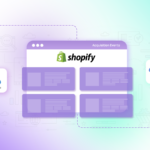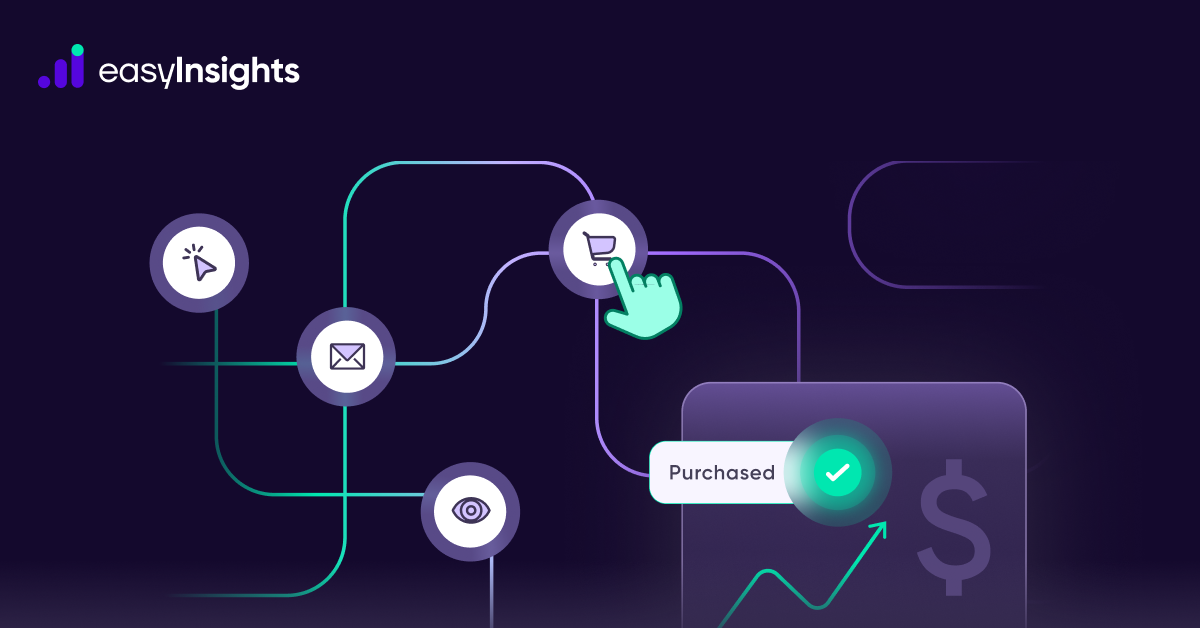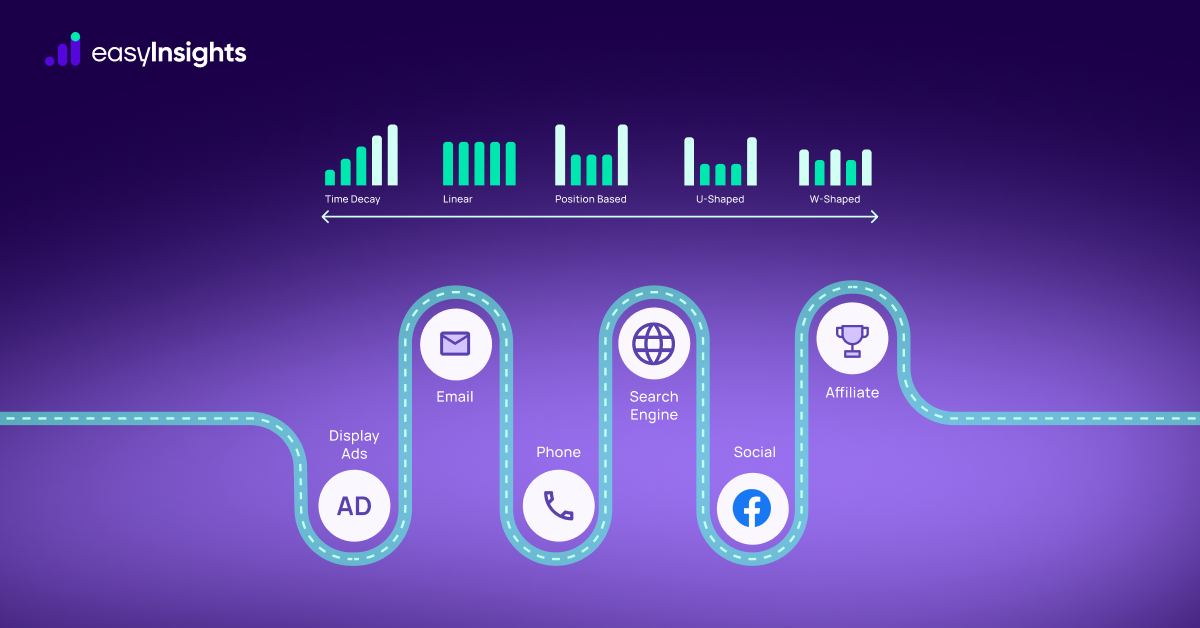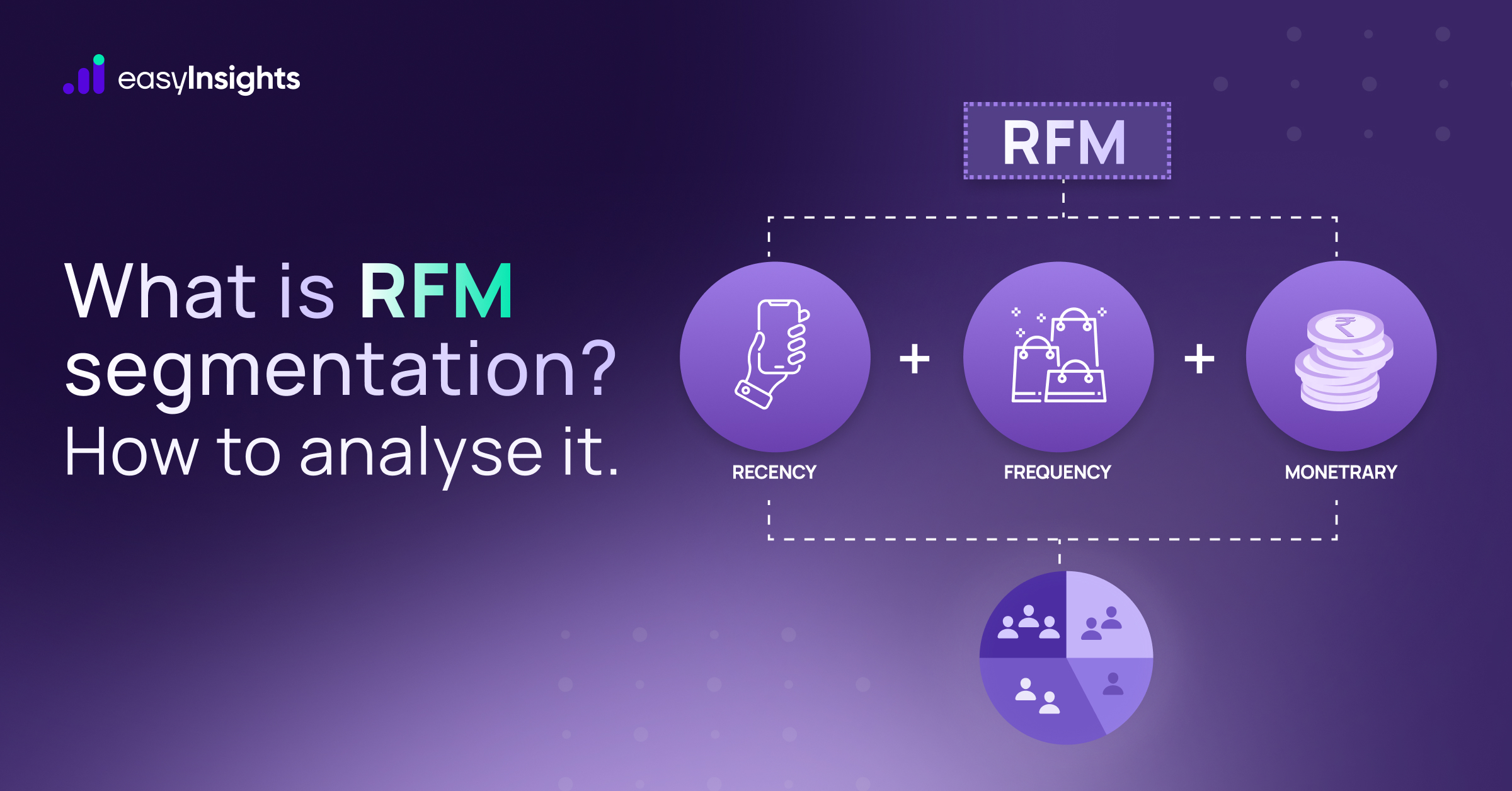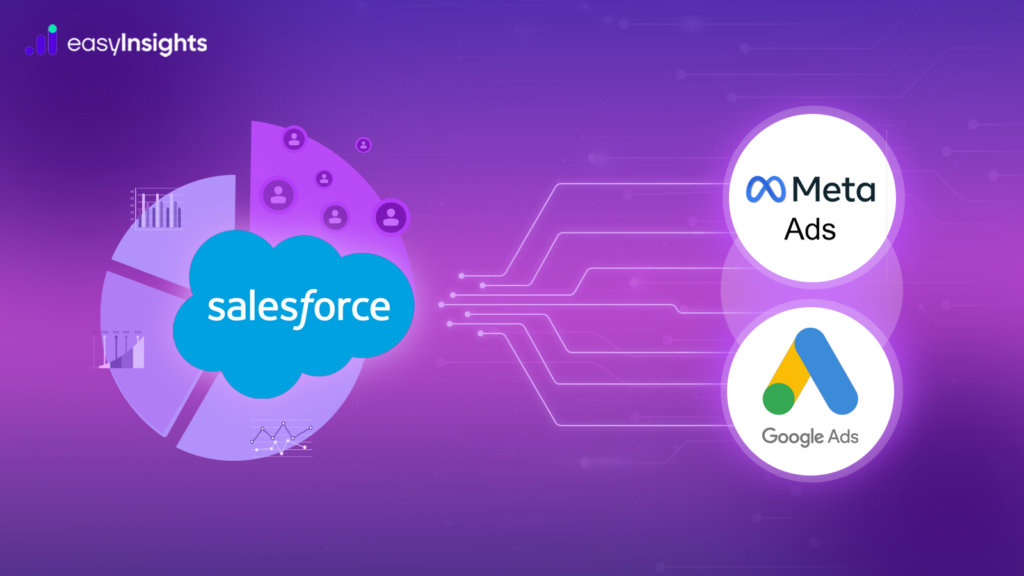
Imagine you run an online fitness coaching and have hundreds of potential clients in Salesforce who showed interest but never signed up. Instead of letting these leads go cold, you can sync them with Meta and Google Ads to retarget them with personalized offers, a gym owner who boosted sign-ups by x% using this strategy. By integrating Salesforce with these ad platforms, brands can improve targeting, personalize ads, and increase conversions, making the most of their existing lead data.
In this blog, we’ll explore why integrating Salesforce with ad platforms like Meta and Google Ads is a game-changer for brands. You’ll learn how it improves targeting, personalizes ads, and increases conversions all by leveraging the data you already have!
Jump ahead to:
Benefits of Integration
Integrating Salesforce lead data with Meta and Google Ads can significantly enhance your marketing efforts. Instead of relying on generic targeting, you can use real customer insights to improve ad relevance, boost engagement, and drive higher conversions. Here’s how:
a) Enhanced Audience Targeting
One of the biggest advantages of syncing Salesforce with Meta and Google Ads is precise audience targeting. Instead of showing ads to a broad audience, you can reach the people who are most likely to convert.
- Lookalike Audiences on Meta:
Meta’s Lookalike Audience feature allows brands to find a new target audience who resembles their existing leads. When you upload your Salesforce lead data to Meta, it analyzes common characteristics such as demographics, interests, and behaviors and then finds new people who match these traits. This helps brands expand their reach while maintaining high-quality prospects. - Customer Match on Google Ads:
Google Ads offers Customer Match, which enables brands to target ads to specific individuals who have previously interacted with them. By uploading Salesforce lead data to Google, you can adjust ads across Search, YouTube, Gmail, and Display Network to past leads, ensuring they don’t forget about your brand. - Retargeting Past Leads for Higher Conversions:
Many leads enter your sales funnel but don’t convert immediately. Instead of losing them, you can retarget them with personalized ads on Meta and Google. For example, if someone inquired about a service but didn’t book an appointment, you can retarget them with an ad offering a special discount or a free consultation.
b) Improved Personalization & Ad Relevance
Consumers today expect personalized experiences. If your ads don’t resonate with them, they’re likely to ignore them. By using Salesforce lead data, you can deliver highly relevant ads tailored to each individual’s journey.
- Dynamic Ad Creatives Based on CRM Data:
With Salesforce data, you can create dynamic ads that change based on user preferences, past interactions, or purchase history. For example, an e-commerce store can show ads featuring products that a customer previously viewed, while a real estate agency can display available properties based on a lead’s location and budget. - Adapt Messaging to the Lead’s Stage in the Funnel:
Not all leads are at the same stage of the buying process. Some may have just signed up for a newsletter, while others might be on the verge of making a purchase. By segmenting your Salesforce data, you can send awareness-stage ads to new leads and conversion-focused ads to high-intent prospects. For instance, a B2B company can send educational content to early-stage leads and product demos to those closer to purchasing.
c) Increased Conversion Rates
Syncing Salesforce lead data with ad platforms helps brands prioritize warm leads rather than wasting their budget on cold audiences.
- Engaging Warm Leads Instead of Cold Traffic:
Traditional ads often target cold audiences who may have never interacted with your brand before. However, when you retarget leads who have already shown interest, they are far more likely to convert. This is because they are already familiar with your business and may just need an extra push to take action. - Leveraging First-Party Data for Better Ad Performance:
With increasing privacy restrictions and the decline of third-party cookies, first-party data (such as Salesforce lead data) is more valuable than ever. Since this data comes directly from people who have interacted with your brands, it leads to better-performing campaigns, lower acquisition costs, and higher ROI.
d) Automated Lead Nurturing & Sales Alignment
Marketing and sales teams often work in silos, leading to missed opportunities. Integrating Salesforce lead data with ad platforms ensures that high-intent leads are nurtured automatically, keeping them engaged until they convert.
- Syncing High-Intent Leads for Immediate Action:
Some leads are ready to convert but might need an extra nudge. By syncing high-intent leads from Salesforce to Meta and Google Ads, brands can show them targeted ads that encourage immediate action such as limited-time offers or testimonials from satisfied customers. - Closing the Loop Between Marketing & Sales:
When marketing and sales teams have access to the same data, they can work together more effectively. For instance, if a sales rep marks a lead as “lost” in Salesforce, marketing can retarget that lead with special offers, increasing the chances of winning them back. Conversely, if a lead converts, marketing can stop showing ads to avoid wasted budget.
Integrate Salesforce with Meta & Google ads
Integrating Salesforce lead data with Meta and Google Ads ensures better targeting, improved personalization, and higher conversions. But how do you transfer this data efficiently? Brands have multiple options, ranging from automated native integrations to third-party tools and manual uploads. Here’s a detailed guide on how to do it.
a) Using Native Integrations & Tools
Both Meta and Google offer direct integrations with Salesforce, making it easy to sync lead data without manual intervention. These methods provide real-time data transfer, ensuring that your ads are always optimized based on the latest customer interactions.
1. Salesforce to Meta (Conversions API & Offline Conversions)
Meta provides two main ways to sync Salesforce lead data for better ad optimization:
- Conversions API (CAPI):
- This is a server-to-server integration that allows Salesforce to send customer data directly to Meta’s advertising system.
- Unlike browser-based tracking (like the Facebook Pixel), CAPI ensures more accurate conversion tracking, even when users have ad blockers enabled or reject cookies.
- CAPI helps Meta optimize ads based on real actions—such as form submissions, phone calls, or in-store visits—captured in Salesforce.
- Best for: Brands that want real-time tracking and improved data accuracy.
- Offline Conversions:
- Not all customer interactions happen online. If you receive leads through phone calls, in-store visits, or consultations, these conversions won’t be tracked by the Facebook Pixel.
- By syncing Salesforce lead data with Meta’s Offline Conversions, brands can link these interactions to ad campaigns and understand which ads drive real sales.
- Best for: Companies with offline sales processes, such as real estate, healthcare, finance, and automotive.
2. Salesforce to Google Ads (Customer Match & Offline Conversions)
Google Ads also offers two main ways to connect Salesforce lead data:
- Customer Match:
- This feature allows brands to upload first-party customer data (emails, phone numbers, etc.) from Salesforce to Google Ads.
- Google then matches this data to existing users on Search, YouTube, Gmail, and the Display Network.
- With Customer Match, you can:
- Retarget leads who have interacted with your brand before.
- Show personalized ads to past customers based on their purchase history.
- Exclude existing customers from acquisition campaigns to save budget.
- Best for: Businesses looking to re-engage past leads and upsell to existing customers.
- Offline Conversion Tracking:
- Like Meta’s Offline Conversions, Google’s feature allows brands to track offline sales and attribute them to ad campaigns.
- If a lead clicks on your ad but completes their purchase over a phone call or in-store, Salesforce can send this conversion data to Google Ads to optimize campaigns accordingly.
- Best for: Companies with long sales cycles where conversions happen outside of the digital space.
How to Set Up Native Integrations:
- In Salesforce, go to the AppExchange and install the relevant Meta or Google Ads integration.
- Connect your Salesforce account with Meta Business Manager or Google Ads.
- Map your lead fields (name, email, phone number, etc.) to match the ad platform’s requirements.
- Choose whether you want real-time syncing or scheduled updates.
- Enable event tracking for offline conversions and customer interactions.
These integrations ensure seamless and automated data transfers, reducing manual effort while improving ad performance.
b) Manual Uploads (When to Use & Best Practices)
For brands that don’t need real-time automation or deal with small datasets, manual uploads are a viable option. How Manual Uploads Work:
- Export lead data from Salesforce as a CSV file.
- Format the data to match Meta’s Custom Audience or Google’s Customer Match template.
- Upload the file to Meta Ads Manager or Google Ads.
- The platform will match the data with existing users and create a custom audience for ad targeting.
c) Third-Party Integration Tools
One of the most reliable ways to improve your ad targeting and attribution is by syncing clean, first-party lead data from your CRM directly into Meta and Google Ads. EasyInsights connects your CRM, ad platforms, and backend systems through a seamless, real-time data pipeline that ensures every customer interaction is tracked, enriched, and activated—without code or complexity.
Integrate your CRM data with EasyInsights
- Automatically sync your CRM data (Zoho, HubSpot, Salesforce, etc.) with Meta’s Custom Audiences and Google’s Customer Match — ensuring your ad platforms are always working with the most up-to-date, consented first-party data.
- EasyInsights supports both Meta’s Pixel and Conversions API, giving you complete event tracking and audience sync — no need to choose one or maintain both manually.
- No manual exports. No spreadsheets. No waiting on developers. Just real-time audience syncing and event tracking that works across your entire funnel.
Whether you’re retargeting high-intent leads, building smarter lookalike audiences, or tracking offline conversions, EasyInsights ensures your CRM data becomes a performance-driving asset inside Meta and Google Ads.
More conversions. Better attribution. And a fully automated workflow that scales with your growth.
Also Read: How to Send Lead Data From HubSpot to Meta & Google Ads
Conclusion
Syncing Salesforce lead data with Meta and Google Ads helps brands improve targeting, personalize ads, and increase conversions by leveraging real customer insights. Instead of spending money on broad, generic ads, brands can focus on high-intent leads, ensuring better engagement and higher ROI. This integration also enables accurate tracking, reduces wasted ad spend, and streamlines marketing efforts. To make the process even easier, platforms like EasyInsights help automate data activation, conversion tracking, and attribution, ensuring brands get the most out of their CRM data for smarter advertising decisions.
Sign up for a demo today to see EasyInsights in action.



